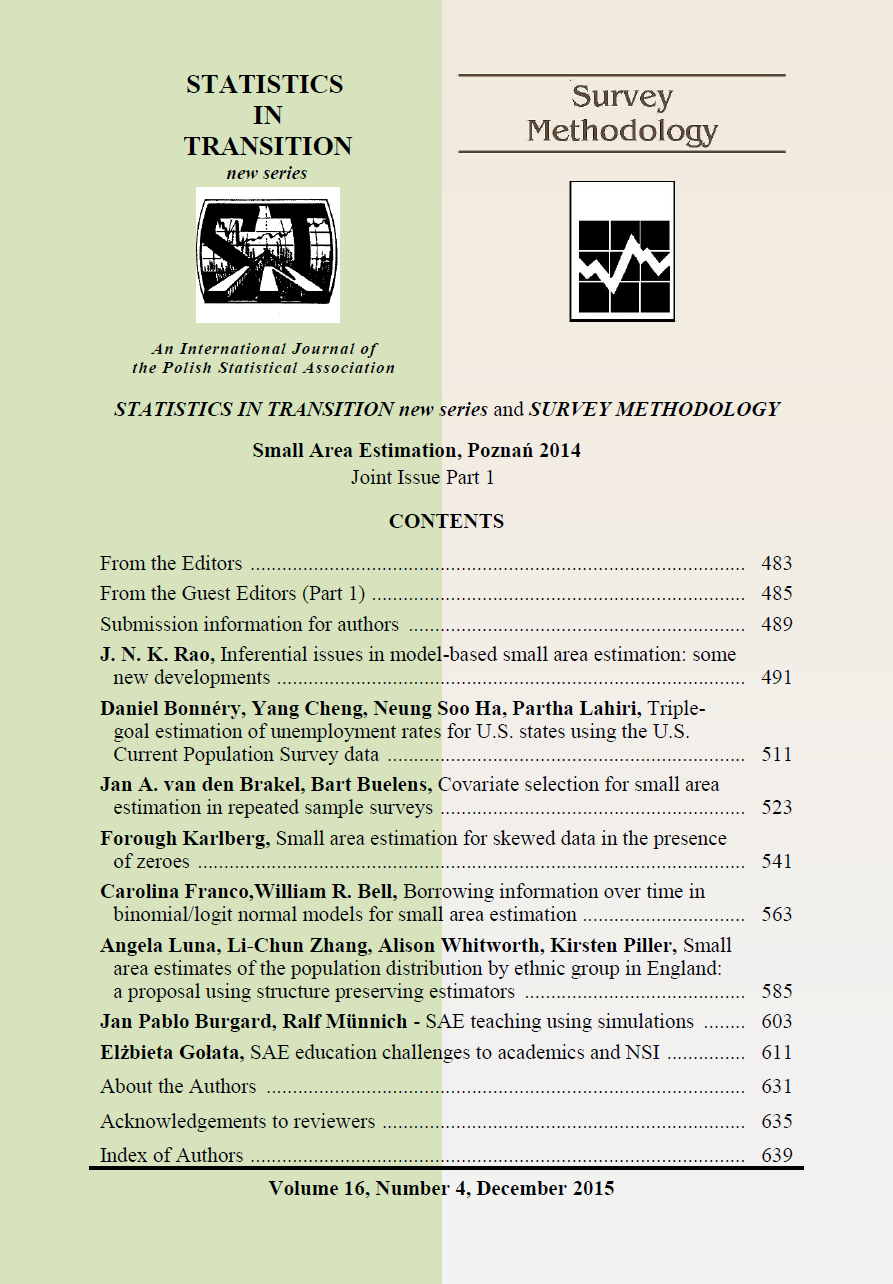ARTICLE
ABSTRACT
The aim of the paper is to present some experiences in teaching Small Area Estimation (SAE). SAE education experiences and challenges are analysed from the academic side and from the NSI side. An attempt was undertaken to discuss SAE issues in a wider perspective of teaching statistics. In particular, the topics refer to Polish conditions, but they are presented against the background of selected international experiences and practices. Information comes from a special inquiry - a survey conducted among employees of statistical offices and academics from universities involved in SAE research. A further issue is inclusion of SAE in the EMOS project (European Master in Official Statistics). The survey is extended with information collected by monitoring of trainings and projects organized by the leading centres dealing with SAE. The results obtained are related to a similar survey within Eurostat project: ESSnet on Small Area Estimation, which was conducted in 2010. The study includes interest in learning and the need to implement SAE methodology, a range of subjects taught as well as a range of applications, forms of training, type of courses, software used and teaching methods. In particular, it intends to answer how strong the interest in small area estimation is, what the demand for practical and theoretical knowledge in the field is and what the recommendations for universities and statistical institutes are.
KEYWORDS
Small Area Estimation, statistical education.
REFERENCES
MAPLES, J. J., BELL, W. R., HUANG, E. T., (2009). Small Area Variance Modelling with Application to County Poverty Estimates from the American Community Survey Statistical Research Division, U.S. Census Bureau, Washington, DC.
BURGARD, J. P., MÜNNICH, R., (2014). SAE teaching using simulations, presentation during International Conference on Small Area Estimation SAE Poznan 2014.
BURGARD, J. P., MÜNNICH, R., ZIMMERMANN, T., (2014). The Impact of Sampling Designs on Small Area Estimates for Business Data, Journal of Official Statistics, Volume 30, Issue 4.
CHAMBERS, R., CHANDRA H., SALVATI, N., TZAVIDIS, N., (2013). Outlier robust small area estimation. Journal of the Royal Statistical Society: Series B (Statistical Methodology), Volume 76, Issue 1, pages 47–69, January 2014.
CHANCE, B., (2002). Components of Statistical Thinking and Implications for Instruction and Assessment. Journal of Statistics Education Volume 10, Number 3 (2002).
DATTA, G. S., (2009). Model-based approach to small area estimation, in: Handbook of Statistics: Sample Surveys: Inference and Analysis, Volume 29B, Eds.: D. Pfeffermann and C.R. Rao, The Netherlands: North-Holland, pp. 251-288.
DATTA, G. S., HALL, P., MANDAL, A., (2011). Model selection by testing for the presence of small-area effects, and applications to area-level data. Journal of the American Statistical Association, 106, 361-374.
FULLER, W. A., (2009). Sampling Statistics, Hoboken, New Jersey: John Wiley & Sons.
GHOSH, M., (2001). Model-Dependent Small Area Estimation – Theory and Practice, in: Lectures Notes on Estimation for Population Domains and Small Areas, eds. R. Lehtonen, K. Djerf, „Reviews” no. 5, Statistics Finland, University of Jyväskylä.
GHOSH, M., RAO, J. N. K., (1994). Small Area Estimation: An Appraisal, „Statistical Science”, Vol. 9, No. 1.
GHOSH, M., KUBOKAWA, T., KAWAKUBO, Y., (2014). Benchmarked Empirical Bayes Estimators for Multiplicative Area Level Models. presentation during International Conference on Small Area Estimation SAE Poznan 2014.
GRAF, E. TILLÉ, Y., (2014). Variance Estimation Using Linearization for Poverty and Social Exclusion Indicators. Survey Methodology. June 2014, Vol. 40, No. 1.
HIDIROGLOU, M. A., SMITH, P., (2005). Benchmarking through calibration of weights for microdata. Working Papers and Studies, European Communities, Eurostat, Luxembourg.
KALTON, G., CITRO, C. F., (2001). Small-Area Estimates of School-Age Children in Poverty. Division of Behavioral and Social Sciences and Education, Commission on Behavioral and Social Sciences and Education,Committee on National Statistics.
LEHTONEN, R., (2014). Experiences and challenges in teaching Small Area Estimation, presentation during International Conference on Small Area Estimation SAE Poznan 2014.
LONGFORD, N. T., (2005). Missing Data and Small-Area Estimation, Springer.
PFEFFERMANN, D., (2011). Modelling of complex survey data: why is it a problem? How should we approach it? Survey Methodology, 37, (2),115-136.
PFEFFERMANN, D., (2013). New important developments in small area estimation. Statistical Science, 28, (1), 40-68.
PLATEK, R., RAO, J. N. K., SÄRNDAL, C. E., SINGH, M. P., (1987). Small Area Statistics. An International Symposium. John Wiley & Sons. Ltd.
PKA 2014. The report on the program assessment held on 17-18 May 2014 for the field of study: computer science and econometrics conducted within the area of social sciences (first- and second-degree) at the Faculty of Informatics and Electronic Economy, Poznan University of Economics, State Accreditation Commission), http://ue.poznan.pl/data/upload/articles/20141031/ce25bb287995611010/011-4-raport-pka-2014.pdf.
RAO, J. N. K., (2003). Small Area Estimation, John Wiley & Sons. Ltd.
RAO, J. N. K., SINHA, S. K., DUMITRESCU, L., (2014). Robust small area estimation under semi-parametric mixed models. Canadian Journal of Statistics, 42(1), 126–141.
SÄRNDAL, C-E. LUNDSTR?M S., (2005). Estimation in Surveys with Nonresponse, John Wiley & Sons, Ltd.
SÄRNDAL, C-E., (2007). The Calibration Approach in Survey Theory and Practice, Survey Methodology, Vol. 33, No. 2, 99–119.
SORVILLO, M. P., (2014). EMOS as a new tool for training professionals in official statistics: NSIs’ point of view, Paper available on EMOS website: http://www.crosportal.eu/sites/default/files//NTTS2013fullPaper_241%20Sorvillo.pdf.
SZYMKOWIAK, M., (2010). ESSnet on Small Area Estimation. Report on the analysis of questionnaires used in WP 2, October 2010.
TORABI, M., SHOKOOHI, F., (2015). Non-parametric generalized linear mixed models in small area estimation. Canadian Journal of Statistics Volume 43, Issue 1, pages 82–96, March 2015.
WALLGREN, A., WALLGREN, B., (2007, 2014). Register-based Statistics. Statistical Methods for Administrative Data. John Wiley & Sons. Ltd.
WALLGREN, A., WALLGREN, B., (2013). Quality Assessment in Systems with Registers and Sample Surveys. http://www.statistics.gov.hk/wsc/IPS078-P2-S.pdf.
ZHANG, L.-C., (2012). Topics of statistical theory for register-based statistics and data integration. Statistica Neerlandica, Vol. 66, No. 1. p. 41–63
